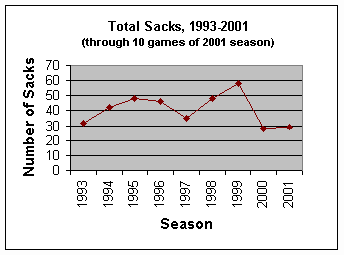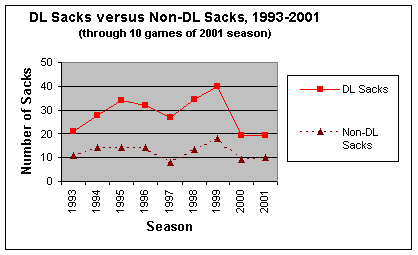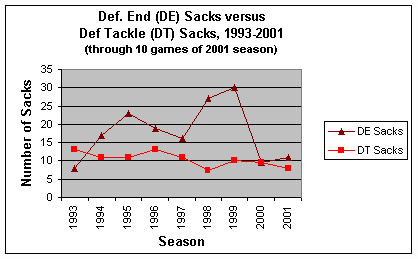
Inside the Numbers: Sackmasters
by Will Stewart, TechSideline.com
TSL Extra, Issue #13
Since Phil Elmassion installed the Hokie defense in 1993, the cornerstone of its philosophy has been one simple
edict: attack the quarterback. As a matter of fact, the word "attack" is part of the term that is used most
often to describe this defense, which doesn't really have a formal name but is most often referred to as the
"attack defense."
The philosophy is simple: first, stack the line to stop the run. Second, using a gambling, blitzing style, pressure
the other team's quarterback relentlessly until he makes a mistake in the passing game. You'll occasionally give up the
big play, more so when your personnel is inexperienced or doesn't know their assignments, but very few teams will be
able to mount sustained drives.
The opposing offense will typically have to convert a lot of third downs to mount long drives, and if you're
pressuring the QB, he will more than likely make a mistake before he can convert enough third downs to take the ball all
the way downfield.
Blitzing is important to the success of the attack defense, but getting pressure from the four down linemen is
probably more important. Blitzing may look intimidating and may make the fans happy, but a truly effective defense is
able to pressure a quarterback with the four down linemen while keeping the linebackers and safeties in coverage.
Watching the 2000 and 2001 versions of the Hokie defense, one nagging suspicion cannot be escaped: the Hokies haven't
been very good at pressuring the quarterback during the last two seasons, particularly with the four down lineman, and
particularly from the defensive end spot. A fan base and coaching staff that was spoiled by pass rushing greats like
Cornell Brown, John Engelberger, and Corey Moore find themselves looking for that next double-digit sacker from the
defensive end position -- and not finding him.
Without great passing rushing defensive ends the last two seasons, the Hokies as a team have still been very solid.
The 2001 defense, after ten games, was #1 in the country in yards allowed per game. So while their sack statistics have
been down the last two years, it has not crippled the ability of the team to win nor of the defense to be effective.
But still, what are the numbers behind this nagging perception that the Hokies just don't bring the heat like they
used to? If we start compiling sack statistics of the Beamer Bowl era (1993-present) and start taking a closer look,
what do we find � Inside the numbers?
(Note that in the following statistical analysis, all stats are regular season stats only. Bowl games are not
included.)
Total Sacks
In 1993, in the first year of the attack defense, the Hokie defense was young. Tech started nine players who were
freshmen or sophomores. They took their lumps often that year, but by the time they flattened Indiana 45-23 in the 1993
Independence Bowl, the Hokies were gelling and coming into their own defensively, behind true freshman defensive end
Cornell Brown.
The 1993 Hokies posted just 32 sacks. It sounds odd to say "just" 32 sacks, because that's almost three
sacks a game. But in the years since then, Hokie fans have become used to 40 sacks or more a season, and Virginia Tech
even approached 50 sacks in a couple of seasons in the mid-90's, before finally shattering that mark with 58 sacks in
1999.
After the 1993 season, only one Tech defense failed to register more than 40 sacks in a season; the 1997 Hokies, who
were breaking in six new starters and were riddled with injuries, only totaled 35. From 1994-1999, Tech averaged an
impressive 44.1 sacks a season.
|
Season |
Total Sacks |
Top Sackers |
|
1993 |
32 |
D. Knight 4, J.C. Price 4, 6 tied w/3 |
|
1994 |
42 |
C. Brown 11, J. Baron 5, G. DelRicco 4 |
|
1995 |
48 |
C. Brown 14, J.C. Price 8, H. Coleman 7 |
|
1996 |
46 |
C. Brown 8, K. Hairston 6, J. Engelberger 6 |
|
1997 |
35 |
J. Engelberger 6, C.Moore 4.5, K. Hairston 3.5, N. Williams 3.5 |
|
1998 |
48 |
C. Moore 13.5, J. Engelberger 7.5, M. Hawkes 5.5 |
|
1999 |
58 |
C. Moore 17, J. Engelberger 7, C. Bird 6 |
|
2000 |
28 |
N. Adibi 5, D. Pugh 5, J. Davis 3.5 |
|
2001* |
29* |
B. Taylor 4.5, J. Davis 4.5, D. Pugh 3.5, C. Colas 3.5 |
|
* Through 10 games |

But in the year 2000, Hokie sack production fell off a cliff, and Tech only registered 28 sacks, a dropoff of 36
percent from the 44.1 sacks-per-season average of 1993-99. That was less than half the total of 1999 and the lowest in
the eight seasons of "attack defense" football. The lack of production was traced primarily to a green corps
of defensive ends, a two-deep rotation that consisted of three freshmen and a sophomore.
So far in the 2001 season, the Tech defense hasn't fared much better, posting 29 sacks in their first ten games.
Given that Tech's last opponent, the Miami Hurricanes, have only given up two sacks all season long (that is not
a misprint), Tech is not likely to add many more sacks to their 2001 total. If they don't get to Miami's Ken Dorsey at
all on December 1st, it will be the second year in a row the Hokies have not totaled over 30 sacks.
Why the big dropoff? The answer lies in sack production, or lack thereof, from the defensive line, most notably the
defensive ends. Let's break things down a little further.
Defensive Line Sacks Versus Other Sacks
The Hokie defenses from 1993 to the present have received 69.5% of their sacks from their defensive linemen. The
year-by-year percentages range from a high of 77.1% in 1997 (27 of 35 sacks) to a low of 65.5% so far in the 2001 season
(19 of 29).
|
Season |
DL Sacks |
Other Sacks |
DL Percent. |
|
1993 |
21 |
11 |
65.6 |
|
1994 |
28 |
14 |
66.7 |
|
1995 |
34 |
14 |
70.8 |
|
1996 |
32 |
14 |
69.6 |
|
1997 |
27 |
8 |
77.1 |
|
1998 |
34.5 |
13.5 |
71.9 |
|
1999 |
40 |
18 |
69.0 |
|
2000 |
19 |
9 |
67.8 |
|
2001* |
19* |
10* |
65.5 |
|
Totals |
254.5 |
111.5 |
69.5 |
| * Through 10 games |

The last two seasons have been uncharacteristically unproductive from the defensive line. From 1993-1999, the DL
averaged almost 31 sacks a year. The last two seasons, they have averaged just 19, a dropoff of nearly 40 percent.
What about sacks from the other positions? From 1993-1999, the Hokies averaged 13.2 non-DL sacks a year. In the last
two years, they have averaged 9.5, a dropoff of 28 percent. This is much less than the 40 percent decrease in production
of the defensive line, but it is still significant.
Defensive End Sacks Versus Defensive Tackle Sacks
When you start to analyze the defensive end spot versus the defensive tackle spot, you sadly start to find out that
the blame for the dropoff in defensive line sack production is not shared between the DE's and DT's.
|
Season |
DE Sacks |
DT Sacks |
DE Percent. |
|
1993 |
8 |
13 |
38.0 |
|
1994 |
17 |
11 |
60.7 |
|
1995 |
23 |
11 |
67.6 |
|
1996 |
19 |
13 |
59.3 |
|
1997 |
16 |
11 |
59.2 |
|
1998 |
27 |
7.5 |
78.3 |
|
1999 |
30 |
10 |
75.0 |
|
2000 |
9.5 |
9.5 |
50.0 |
|
2001* |
11* |
8* |
57.9 |
|
Totals |
160.5 |
94 |
63.1 |
| * Through 10 games |

You can see from the table and the graph that sack production from the defensive ends has fallen off dramatically in
the last two seasons. From 1993-1999, the Hokies averaged 20.3 sacks a year from the defensive end spot, and that
includes the ultra-low total of 8 from 1993. If you look at 1994-1999, Tech averaged 22 sacks a year from the defensive
ends.
But in the last two seasons, the Hokies have gotten just 10.3 sacks a year from the defensive ends, a decrease of
49.3% from the 1993-1999 average.
You can see from the figures that sack production from the defensive ends fluctuates wildly over time. It peaked with
the great defensive lines of 1995 (Cornell Brown) and 1999 (Corey Moore and John Engelberger) and dipped in other years.
Sacks from the defensive tackles, on the other hand, have been remarkably consistent of the years.
The tackles averaged 10.9 sacks per year from 1993-1999. They have stayed relatively close to that figure the last
two seasons, but yet sack production is down, to 8.8. This is a reduction of 19.3% from the norm.
Of course, over the last two seasons, the defensive end rotation has included mostly freshmen and sophomores, while
the defensive tackle rotation has been led by David Pugh and Chad Beasley, who were juniors in 2000 and seniors in 2001.
Conclusions
In absolute terms, the reduction in sacks from the defensive line can traced mostly to the big dropoff in production
at the defensive end spot. If the ends were averaging 20 sacks per year (the norm) instead of just 10 the past two
seasons, the team as a whole would have close to 40 sacks the past two seasons.
And those sacks could have been vitally important. It's very doubtful that an improved pass rush would have made much
difference in the 2000 Miami game or the 2001 Pittsburgh game, both blowouts, but an extra sack or two could have made
all the difference in the world in the 2001 Syracuse game. And if the Hokies had won the Syracuse game and were 5-1 in
the Big East going into the Dec. 1 clash with Miami, instead of 4-2, they would still have a shot at a BCS bowl.
At this point, you can't predict whether the quartet of Nathaniel Adibi, Cols Colas, Jim Davis and Lamar Cobb will
ever be as effective as the defensive end groups that were led by Cornell Brown in the mid-90's and Corey Moore in the
late 90's. In 1993, 1994, and 1997, those defensive end groups, when they were composed primarily of freshmen and
sophomores, were not very effective, either. The DE's averaged around 13.5 sacks per game in those seasons, but in 1995,
1996, 1998, and 1999, when they were mostly juniors and seniors, those DE's averaged almost 25 sacks per game.
Next year will tell the tale of the current crop of defensive ends. Cobb will be a senior, and the others will be
juniors. If they're ever going to increase their production and take their place among the great Virginia Tech defensive
lines of the past decade, it will start next season. Look for defensive end sack production to increase to 20 sacks per
game or more, and for overall sack production to get back up into the range of 35-40.
But on the other hand, the maturation of the defensive ends may be offset by youth at the defensive tackle,
linebacker, and Rover spots. All of those positions, with the exception of the Whip linebacker spot, will get cleaned
out by graduation at the end of this season.
The Data
You can download the sack data and view it, either as a web page, or as a Microsoft Excel 97 spreadsheet.
http://www.techsideline.com/tslextra/issue013/sackstats.htm
To download the data yourself in Microsoft Excel 97 spreadsheet format, head to this link:
http://www.techsideline.com/tslextra/issue013/sackstats.xls
(Right-click the link and do a "Save Link As" or "Save Target As" to save the Excel file to
disk.)
 

TSLX Home
Copyright © 2001 Maroon Pride, LLC

|



